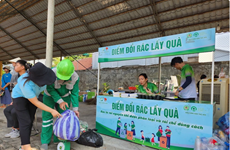Hanoi suburbs stricken by drought
As the dry season prolongs into drought,
residents in Ba Vi District on the outskirts of Hanoi are suffering
from water shortages.
As the dry season prolongs into drought,
residents in Ba Vi District on the outskirts of Hanoi are suffering
from water shortages.
Out of 109 households, home to 502 people in Cao Linh hamlet, Phu Son commune, only 10 have enough water by building their own water storage containers.
"From November to the end of March, there is serious lack of water here, and this year it has worsened due to the long-lasting drought," said Phung Tien Truong, a local official.
The communal People's Committee and residents have asked for water supplies many times but not received a response.
"Besides the weather, Cao Linh is located 600 metres up Phu Huu Hill meaning underground water is scarce. Previously, the hamlet relied on water from the Yen Ngua canal, but that has been gradually filled up by landslides," added Chu Ba Trang from Phu Son commune's People's Committee.
In order to sort out the problem, Phu Son has built three public wells and water containers.
However, the wells, costing an estimated 15-20 VND million (790-1,050 USD), remain empty.
"In 2008, my family invested in building one well, but that hasn't provided any water at the moment. Instead, we have to buy water at 100,000 VND per 4cu.m.
Despite being located at a lower position compared to Phu Son, Phu An hamlet in Thai Hoa commune, the poorest area of Ba Vi district, is also suffering. Out of 86 households, 56 live below the poverty line. They all suffer from water shortages from October to April every year.
"We have to take water from the irrigation canals which have no water in dry season.
The water we take from wells is yellow and very muddy," said Chu Van Cho, Phu An hamlet's Party Secretary.
According to a report from the Hanoi clean water trading company, 38.5 percent of residents in Hanoi get water from urban water systems. In the five districts of Dong Anh, Soc Son, Gia Lam, Thanh Tri and Tu Liem, the rate is 15 percent and only 1 percent for the districts of Hoai Duc, Dan Phuong, Ba Vi, Quoc Oai, Thanh Oai, Ung Hoa, My Duc, Phu Xuyen and Me Linh.
Suburban residents haven't got tap water yet. Instead, they still use water from wells, irrigation canals or rain. Out of 101 water supply stations with capacity of 400-1,600cu.m per day, 89 are currently in operation./.
Out of 109 households, home to 502 people in Cao Linh hamlet, Phu Son commune, only 10 have enough water by building their own water storage containers.
"From November to the end of March, there is serious lack of water here, and this year it has worsened due to the long-lasting drought," said Phung Tien Truong, a local official.
The communal People's Committee and residents have asked for water supplies many times but not received a response.
"Besides the weather, Cao Linh is located 600 metres up Phu Huu Hill meaning underground water is scarce. Previously, the hamlet relied on water from the Yen Ngua canal, but that has been gradually filled up by landslides," added Chu Ba Trang from Phu Son commune's People's Committee.
In order to sort out the problem, Phu Son has built three public wells and water containers.
However, the wells, costing an estimated 15-20 VND million (790-1,050 USD), remain empty.
"In 2008, my family invested in building one well, but that hasn't provided any water at the moment. Instead, we have to buy water at 100,000 VND per 4cu.m.
Despite being located at a lower position compared to Phu Son, Phu An hamlet in Thai Hoa commune, the poorest area of Ba Vi district, is also suffering. Out of 86 households, 56 live below the poverty line. They all suffer from water shortages from October to April every year.
"We have to take water from the irrigation canals which have no water in dry season.
The water we take from wells is yellow and very muddy," said Chu Van Cho, Phu An hamlet's Party Secretary.
According to a report from the Hanoi clean water trading company, 38.5 percent of residents in Hanoi get water from urban water systems. In the five districts of Dong Anh, Soc Son, Gia Lam, Thanh Tri and Tu Liem, the rate is 15 percent and only 1 percent for the districts of Hoai Duc, Dan Phuong, Ba Vi, Quoc Oai, Thanh Oai, Ung Hoa, My Duc, Phu Xuyen and Me Linh.
Suburban residents haven't got tap water yet. Instead, they still use water from wells, irrigation canals or rain. Out of 101 water supply stations with capacity of 400-1,600cu.m per day, 89 are currently in operation./.













